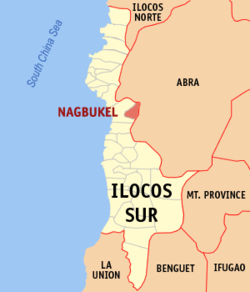Nagbukel
Nagbukel | |
|---|---|
| Municipality of Nagbukel | |
 Map of Ilocos Sur with Nagbukel highlighted | |
 | |
Location within the Philippines | |
| Coordinates: 17°26′49″N 120°31′31″E / 17.4469°N 120.5253°E | |
| Country | |
| Region | Ilocos Region |
| Province | Ilocos Sur |
| District | 2nd District |
| Barangays | 12 (see Barangays) |
| Government | |
| • Type | Sangguniang Bayan |
| • Mayor | Amalia C. Cabrera |
| • Vice Mayor | Randolf John Cabrera |
| • Congressman | Kristine Singson-Meehan |
| • Electorate | 4,076 voters (2022) |
| Area | |
| • Total | 43.12 km2 (16.65 sq mi) |
| Elevation | 87 m (285 ft) |
| Population (2020 census)[3] | |
| • Total | 5,465 |
| • Density | 130/km2 (330/sq mi) |
| • Households | 1,361 |
| Economy | |
| • Income class | 5th municipal income class |
| • Poverty incidence | 16.86% (2015)[4] |
| • Revenue (₱) | ₱ 257.1 million (2020) |
| • Assets (₱) | ₱ 705.3 million (2020) |
| • Liabilities (₱) | ₱ 23.33 million (2020) |
| • Expenditure (₱) | ₱ 55.37 million (2020) |
| Time zone | UTC+8 (PST) |
| ZIP code | 2725 |
| PSGC | |
| IDD : area code | +63 (0)77 |
| Native languages | Ilocano Tagalog |
| Website | www |
Nagbukel, officially the Municipality of Nagbukel (Template:Lang-ilo; Filipino: Bayan ng Nagbukel), is a 5th class municipality in the province of Ilocos Sur, Philippines. According to the 2020 census, it has a population of 5,465 people.[3]
Etymology
The name of the municipality was thought to have come from the round shape of one of the hills in the area. People in the area would utter, "Anian nga nagbukel" (Ilocano meaning "How round it is.").
Another origin of the municipality's name comes from three small hills in the southern part of the municipality.
Another origin of the town's name comes from the irregular distribution of the barangays of Nagbukel and nearby Narvacan. Negotiations were made in such a way that the place east of the Kayapa River become part of Nagbukel and places west of the river become part of Narvacan. The distance from north to south was equal to the distance from east to west. The resulting area is round, hence the name "Nagbukel."
Barangays
Nagbukel is politically subdivided into 12 barangays. [2]
- Balaweg
- Bandril
- Bantugo
- Cadacad
- Casilagan
- Casocos
- Lapting
- Mapisi
- Mission
- Poblacion East
- Poblacion West
- Taleb
Climate
| Climate data for Nagbukel, Ilocos Sur | |||||||||||||
|---|---|---|---|---|---|---|---|---|---|---|---|---|---|
| Month | Jan | Feb | Mar | Apr | May | Jun | Jul | Aug | Sep | Oct | Nov | Dec | Year |
| Mean daily maximum °C (°F) | 30 (86) |
31 (88) |
33 (91) |
34 (93) |
32 (90) |
31 (88) |
30 (86) |
30 (86) |
30 (86) |
31 (88) |
31 (88) |
30 (86) |
31 (88) |
| Mean daily minimum °C (°F) | 19 (66) |
19 (66) |
21 (70) |
23 (73) |
24 (75) |
25 (77) |
24 (75) |
24 (75) |
24 (75) |
22 (72) |
21 (70) |
19 (66) |
22 (72) |
| Average precipitation mm (inches) | 10 (0.4) |
10 (0.4) |
14 (0.6) |
23 (0.9) |
80 (3.1) |
103 (4.1) |
121 (4.8) |
111 (4.4) |
119 (4.7) |
144 (5.7) |
39 (1.5) |
15 (0.6) |
789 (31.2) |
| Average rainy days | 5.2 | 3.9 | 6.2 | 9.1 | 18.5 | 21.4 | 22.9 | 19.8 | 19.8 | 16.2 | 10.5 | 6.1 | 159.6 |
| Source: Meteoblue [5] | |||||||||||||
Demographics
| Year | Pop. | ±% p.a. |
|---|---|---|
| 1918 | 1,979 | — |
| 1939 | 2,497 | +1.11% |
| 1948 | 2,345 | −0.70% |
| 1960 | 2,874 | +1.71% |
| 1970 | 2,978 | +0.36% |
| 1975 | 3,226 | +1.62% |
| 1980 | 3,539 | +1.87% |
| 1990 | 3,806 | +0.73% |
| 1995 | 4,124 | +1.51% |
| 2000 | 4,671 | +2.71% |
| 2007 | 4,764 | +0.27% |
| 2010 | 4,938 | +1.31% |
| 2015 | 5,259 | +1.21% |
| Source: Philippine Statistics Authority[6][7][8][9] | ||
In the 2020 census, the population of Nagbukel was 5,465 people,[3] with a density of 130 inhabitants per square kilometre or 340 inhabitants per square mile.
References
- ^ Municipality of Nagbukel | (DILG)
- ^ a b "Province: Ilocos Sur". PSGC Interactive. Quezon City, Philippines: Philippine Statistics Authority. Retrieved 12 November 2016.
- ^ a b c Census of Population (2020). "Region I (Ilocos Region)". Total Population by Province, City, Municipality and Barangay. Philippine Statistics Authority. Retrieved 8 July 2021.
- ^ "PSA releases the 2015 Municipal and City Level Poverty Estimates". Quezon City, Philippines. Retrieved 1 January 2020.
- ^ "Nagbukel: Average Temperatures and Rainfall". Meteoblue. Retrieved 14 May 2020.
- ^ Census of Population (2015). "Region I (Ilocos Region)". Total Population by Province, City, Municipality and Barangay. Philippine Statistics Authority. Retrieved 20 June 2016.
- ^ Census of Population and Housing (2010). "Region I (Ilocos Region)" (PDF). Total Population by Province, City, Municipality and Barangay. National Statistics Office. Retrieved 29 June 2016.
- ^ Censuses of Population (1903–2007). "Region I (Ilocos Region)". Table 1. Population Enumerated in Various Censuses by Province/Highly Urbanized City: 1903 to 2007. National Statistics Office.
- ^ "Province of Ilocos Sur". Municipality Population Data. Local Water Utilities Administration Research Division. Retrieved 17 December 2016.


